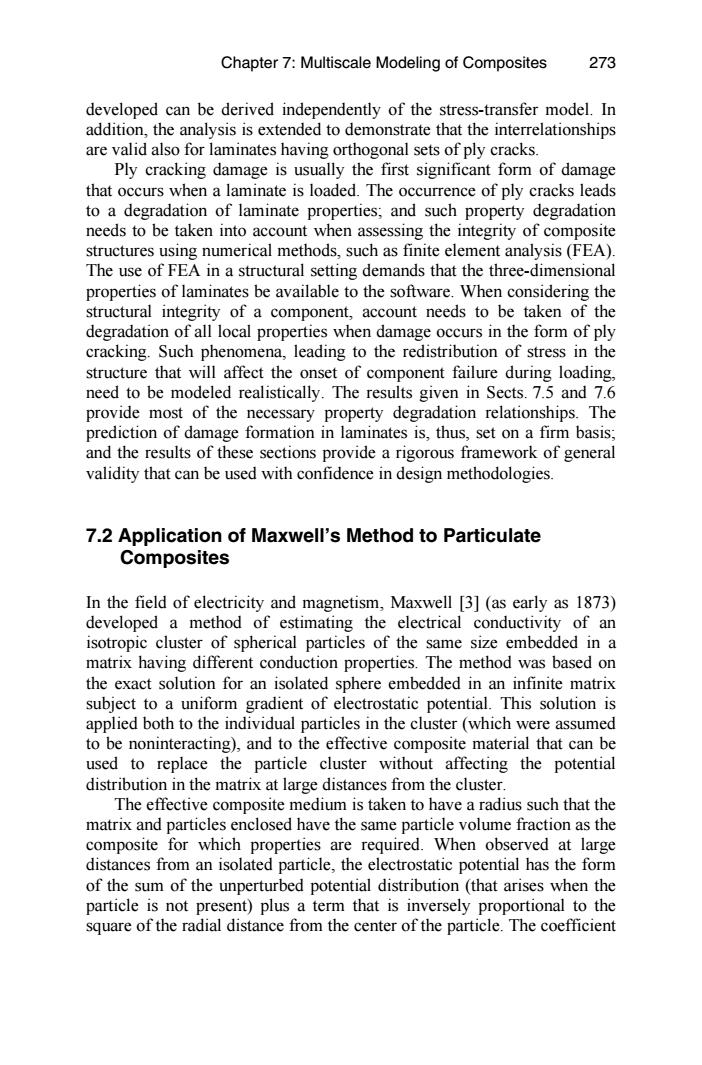正在加载图片...

Chapter 7:Multiscale Modeling of Composites 273 developed can be derived independently of the stress-transfer model.In addition,the analysis is extended to demonstrate that the interrelationships are valid also for laminates having orthogonal sets of ply cracks. Ply cracking damage is usually the first significant form of damage that occurs when a laminate is loaded.The occurrence of ply cracks leads to a degradation of laminate properties;and such property degradation needs to be taken into account when assessing the integrity of composite structures using numerical methods,such as finite element analysis (FEA) The use of FEA in a structural setting demands that the three-dimensional properties of laminates be available to the software.When considering the structural integrity of a component,account needs to be taken of the degradation of all local properties when damage occurs in the form of ply cracking.Such phenomena,leading to the redistribution of stress in the structure that will affect the onset of component failure during loading, need to be modeled realistically.The results given in Sects.7.5 and 7.6 provide most of the necessary property degradation relationships.The prediction of damage formation in laminates is,thus,set on a firm basis; and the results of these sections provide a rigorous framework of general validity that can be used with confidence in design methodologies. 7.2 Application of Maxwell's Method to Particulate Composites In the field of electricity and magnetism,Maxwell [3](as early as 1873) developed a method of estimating the electrical conductivity of an isotropic cluster of spherical particles of the same size embedded in a matrix having different conduction properties.The method was based on the exact solution for an isolated sphere embedded in an infinite matrix subject to a uniform gradient of electrostatic potential.This solution is applied both to the individual particles in the cluster(which were assumed to be noninteracting),and to the effective composite material that can be used to replace the particle cluster without affecting the potential distribution in the matrix at large distances from the cluster. The effective composite medium is taken to have a radius such that the matrix and particles enclosed have the same particle volume fraction as the composite for which properties are required.When observed at large distances from an isolated particle,the electrostatic potential has the form of the sum of the unperturbed potential distribution (that arises when the particle is not present)plus a term that is inversely proportional to the square of the radial distance from the center of the particle.The coefficientdeveloped can be derived independently of the stress-transfer model. In addition, the analysis is extended to demonstrate that the interrelationships are valid also for laminates having orthogonal sets of ply cracks. Ply cracking damage is usually the first significant form of damage that occurs when a laminate is loaded. The occurrence of ply cracks leads to a degradation of laminate properties; and such property degradation needs to be taken into account when assessing the integrity of composite structures using numerical methods, such as finite element analysis (FEA). The use of FEA in a structural setting demands that the three-dimensional properties of laminates be available to the software. When considering the structural integrity of a component, account needs to be taken of the degradation of all local properties when damage occurs in the form of ply cracking. Such phenomena, leading to the redistribution of stress in the structure that will affect the onset of component failure during loading, need to be modeled realistically. The results given in Sects. 7.5 and 7.6 provide most of the necessary property degradation relationships. The prediction of damage formation in laminates is, thus, set on a firm basis; and the results of these sections provide a rigorous framework of general validity that can be used with confidence in design methodologies. 7.2 Application of Maxwell’s Method to Particulate Composites In the field of electricity and magnetism, Maxwell [3] (as early as 1873) developed a method of estimating the electrical conductivity of an isotropic cluster of spherical particles of the same size embedded in a matrix having different conduction properties. The method was based on the exact solution for an isolated sphere embedded in an infinite matrix subject to a uniform gradient of electrostatic potential. This solution is applied both to the individual particles in the cluster (which were assumed to be noninteracting), and to the effective composite material that can be used to replace the particle cluster without affecting the potential distribution in the matrix at large distances from the cluster. The effective composite medium is taken to have a radius such that the matrix and particles enclosed have the same particle volume fraction as the composite for which properties are required. When observed at large distances from an isolated particle, the electrostatic potential has the form of the sum of the unperturbed potential distribution (that arises when the particle is not present) plus a term that is inversely proportional to the square of the radial distance from the center of the particle. The coefficient Chapter 7: Multiscale Modeling of Composites 273